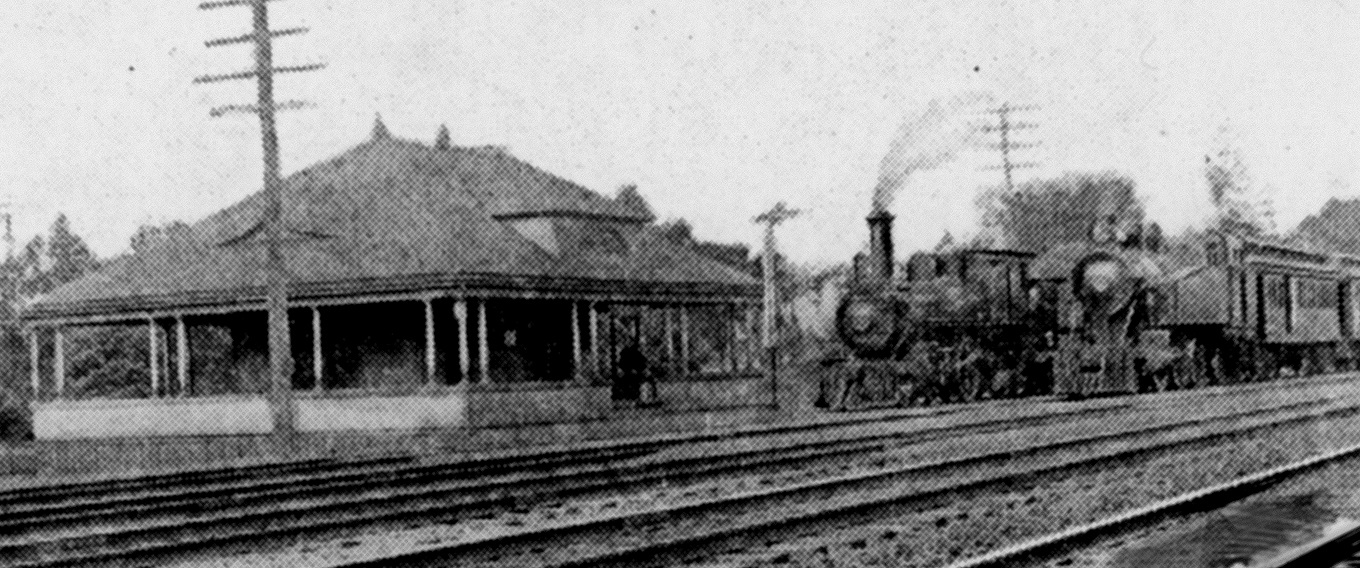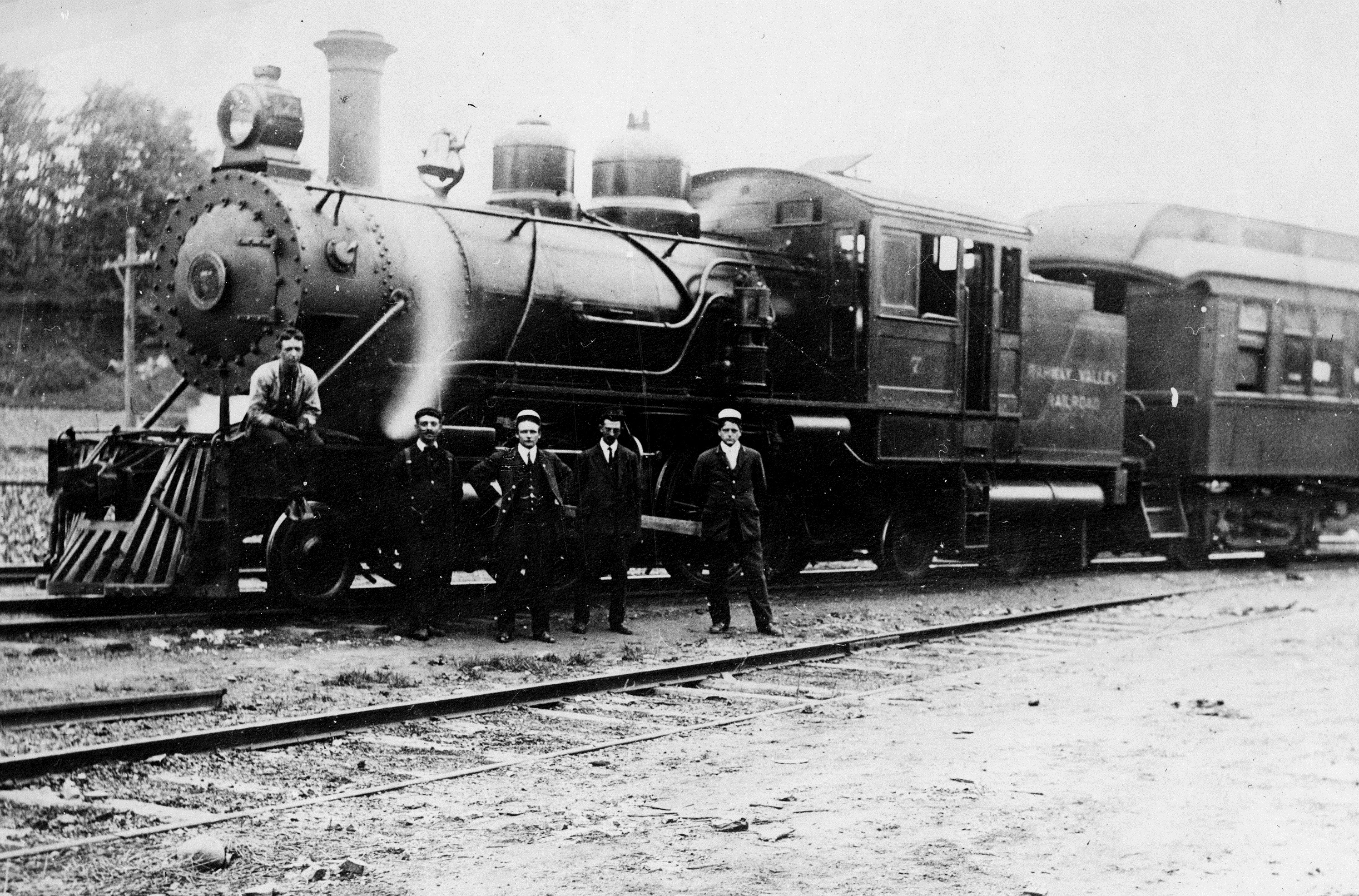|
|
| In these
two stunning views we see NOFJ #3 on her passenger run, consisting
of a single time-worn combine. The first photo, on the left, shows
the train at Aldene and the connection with the Central Railroad of
New Jersey. The second photo, on the right, shows the train coming
off the Lehigh Valley Railroad interchange at Roselle [Park]. This
consist was typical of NY&NO, NOFJ, and RVRR passenger trains.
Left photo from the collection of Jeff Jargosch. Right
photo from the Springfield Public Library.
|
In the late 1890�s the Rahway Valley
Railroad got its start. Only it wasn�t called Rahway Valley yet, it was
called the New Orange Four Junction Railroad, and earlier the New York
& New Orange Railroad. At its earliest, the NOFJ began to haul
passengers from Aldene and Roselle (not yet called Roselle Park), to New
Orange and later, under the Rahway Valley Railroad banner, to
Springfield, and then up the hill to Summit. A connection was made with
the Central Railroad of New Jersey at Aldene, where their new Cranford
yard was beginning to come alive. Passenger service began to make
commuting to the City and larger towns easier to local citizens. You could
travel on RVRR trains from Springfield to Townley on the Lehigh Valley, or
off the Lackawanna at Summit to Jersey City on the Central Railroad of New
Jersey. This was real progress.
 |
| Here we see NOFJ
#3 as she pulls her train into the New Orange Station. Had the train
been heading to Aldene from here, the engine would have backed its
train down. Photo courtesy of Don
Maxton. |
|

|
| Seen
here is NOFJ (earlier NY&NO) #2, with her train, meeting a
passenger train of the CRRofNJ. #2 backed her train down from New
Orange all the to Aldene. The track closest to the Aldene Station
was property of the New Orange Four Junction Railroad (later RVRR).
McCoy Collection, courtesy of Don
Maxton. |
The NOFJ (or NY&NO) had built
a station in Aldene along the CRRofNJ mainline. From all
indications NOFJ trains, usually a combine and coach, were backed
down from New Orange, the engine running backward at the end of the train.
Old records mention a crossing guard at Westfield Avenue (then North
Avenue). Although traffic was light, mostly horse and wagon, a few early
autos, and an occasional trolley, there were no air whistles and a flagman
would have to guide the train across.
Locomotive #3 in the old photographs
appears to be one of the ex-PRR 4-4-0�s. After meeting the CRRofNJ
connection #3 would pull, locomotive leading back across Westfield Avenue,
along Valley Road, and across Michigan to the junction. Again, #3 backs
down to Colfax and Webster Avenues and around the curve into the track
alongside the Lehigh Valley�s main. Passengers just crossed the tracks to
the LV�s big Victorian depot for connecting trains, possibly swapping
express or LCL.
Then it was off to New Orange and points
west. At Springfield, the only passing siding on the line, the engine
would uncouple and run around to the rear of the train and push the
coaches up the steep hill, through Baltusrol, to Summit, protecting the
cars from a runaway with the locomotive on the rear. There was an incident
of the coaches getting away downhill prompting management to act to avoid
future thrill rides.
|
|
| These two views show how
after the engine was runaround the train at Springfield, the train
would be pushed up the hill to Summit. The photograph on the left
shows #7 pushing a combine between Springfield and Baltusrol. The
photograph on the right shows #7 and a train in Summit, with the
engine on the east end. The locomotive had pushed the coaches up the
mountain and into the spur that led to the RVRR's Summit Station.
The Summit Station had three stub tracks but no runaround to move
the engine around the train. Left photo taken by George
Whitfield. Right photo courtesy of Don Maxton.
|
If the rails were wet, or the trains
were particularly heavy, the locomotive would use the siding at
Baltusrol to split the cars and take one or two at a time up the
stiff grade, hence �doubling� the hill, obviously a time consuming
process. I guess the schedule went out the window
there!
Photos at Summit�s small terminal show the
engines on the downhill end of the train. On reaching Springfield, and the
flat land, the swap was again made and the cars led the way, engines
running backward to the start. Remember, a 1906 timetable shows 10 trains
a day were run in this fashion. Hoo-boy!
 |
|
Here we see #7,
and crew, out along the line with the passenger varnish, about to
head out on another run.
McCoy Collection, courtesy
of Don
Maxton. | |